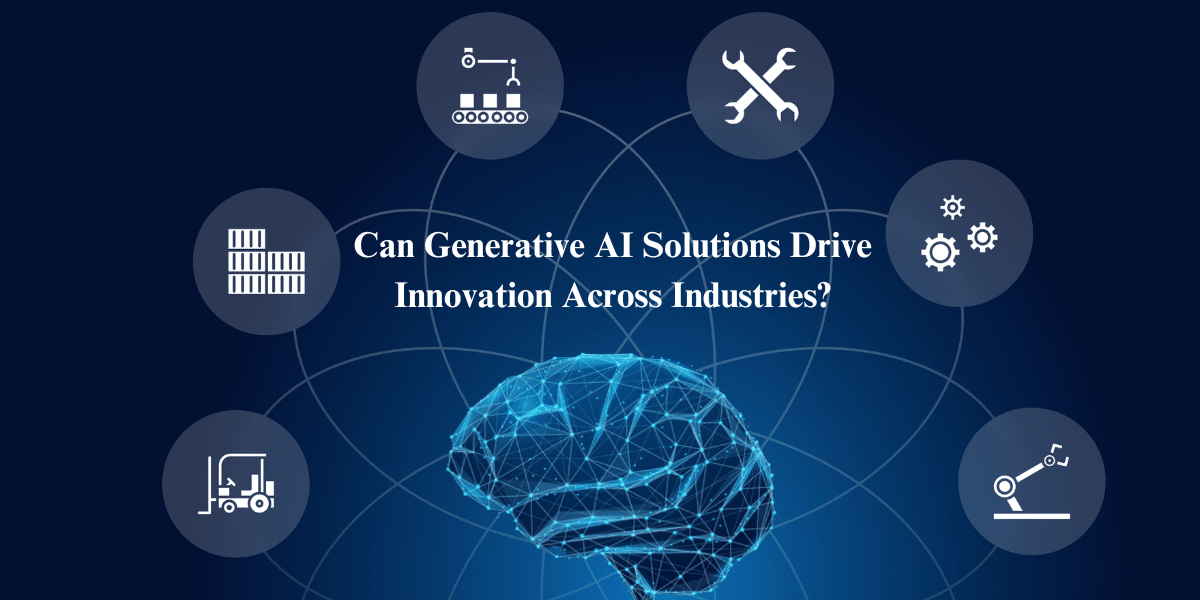The latest generation of Generative AI technologies can revolutionize the entire industry. Generative Artificial Intelligence (AI) is rapidly becoming a highly revolutionary technological advancement of the present that is changing the way we design new ideas, develop, and conduct business in various fields. From the world of marketing and entertainment to finance and healthcare, the impact of generative AI is significant and vast. This fantastic technology that can create innovative solutions and content based on data feeding is set to transform the human landscape of creativity and problem-solving.
The essence of Generative AI is more than automating tasks. It’s about improving human abilities and opening new possibilities for creativity. Suppose it’s about creating captivating narratives through digital art, streamlining software development, and transforming drug discovery or optimizing the financial model and models. In that case, Generative AI Solutions is at the top of technological development.
The number of possible AI applications that the generative AI provides can be awe-inspiring. It doesn’t matter if you’re a health professional looking for more precise diagnostics, a financial analyst trying to navigate complex markets, a marketing professional looking to engage viewers, or a teacher seeking a personalized learning experience; Generative AI is a powerful tool to give.
Businesses will see the opportunity to innovate and efficiency that allows companies to compete in an ever-changing global environment. Individuals can also open the doors to new possibilities in enhancing their skills and quality of living.
This post will extensively guide the most popular Generative AI use cases across sectors. The article will discuss how Generative AI alters our thinking in creation, life, and work.
What Is Generative AI?
To gain an edge in business, executives must first know the meaning of generative AI.
Generative AI refers to algorithmic techniques that can create seemingly unique real-world content from training data, such as texts, images, or even sound. The most effective generational AI algorithms are constructed upon foundational models, which have been trained on an enormous amount of data that is not labeled using self-supervised methods to discover the relevant underlying patterns that can be used to solve a range of jobs.
In this case, GPT-3.5, a foundation model trained using large amounts of text, can be modified to address questions, summarize text, or even perform sentiment analysis. DALL-E, the multimodal (text-to-image) base model, can be used to design pictures, increase the size of images over their initial size, and even create new variations on existing images.
What Is The Process Behind Generative AI work?
Generative AI is a new frontier in artificial intelligence. Machines aren’t just passive recipients and processors of information; rather, they actively create new and original content. The ability to transform is embedded in AI’s capability to learn from huge databases and absorb patterns, styles, and patterns to create fresh content that, although reflecting the learning data, is completely new.
The functions that comprise Generative AI are underpinned by advanced algorithms and neural networks like Generative Adversarial Networks (GANs), Variational Autoencoders (VAEs), and Transformer models. Generative AI relies on these models for effective operation, and their role is critical in carrying out various tasks ranging from creating realistic pictures and videos to producing human-sounding texts and music.
The entire process starts with the initial training phase, during which the AI systems consume immense quantities of information. For example, models designed to produce texts are trained using large volumes of texts – this helps teach its subtleties of style, language, and grammar. A model that aims to create images will be able to learn from a vast selection of pictures, understanding the patterns, colors, and compositions.
Generative Adversarial Networks (GANs) clearly show this procedure. GANs consist of two elements: the generator that generates material and the discriminator that analyzes the content. The generator generates instances of new data, and the discriminator evaluates them against actual instances. Then guides the generator to enhance its output regularly. Internal competition causes the GAN to deliver high-quality, real-world outputs that appear identical to real-world documents.
Another crucial aspect of the method by which Generative AI Software Solutions works is its dependence on deep learning and reinforcement learning. These AI subsets let the system improve the outputs it produces based on feedback and become more adept at creating content that meets the requirements. Learning through iterative processes and feedback loops allows Generative AI models to attain extraordinary creativity and real-world output accuracy.
In addition, Transformer models have transformed the field, creating more contextually aware models for natural language processing tasks. The models can consider all the contexts of an input, making them highly efficient in creating consistent and relevant texts in long passages.
Generative AI’s capacity to produce new content is a complicated combination of data analysis, pattern recognition, and learning. This technology’s power is its versatility and potential to change how people produce, invent, and use digital content in a range of sectors. By harnessing the enormous amount of information available and using these complex algorithms, Generative AI constantly tests what machines can achieve, providing glimpses into a future where AI’s full creative potential is fulfilled.
Advantages And Benefits Of Using Generative AI In Business
Generative Artificial Intelligence (AI) is a remarkable technological advancement that has the potential to change business innovations. It refers to AI machines that produce innovative and distinctive designs, content, or products without having to be explicitly programmed to do so. In this article, we’ll explore the advantages of generative AI for business.
Performance and speed
One of artificial intelligence’s primary benefits is its capability to produce many concepts or suggestions rapidly. This could significantly boost efficiency for businesses as it removes the requirement to hold time-consuming and labor-intensive human brainstorming sessions. Through generative AI, companies can swiftly create a variety of concepts or strategies, which can save time and money.
Innovation and Creativity
Generative AI can increase employees’ creativity and spur innovation within companies by inventing new ideas or concepts humans might have never considered. The generative AI algorithms can detect connections and patterns between incompatible concepts by analyzing vast amounts of information and data. They can then generate innovative ideas that have the potential to be successful. This ability allows companies to remain ahead of their competition and develop creative and original strategies.
Cost-effective
Another significant advantage of using Generative AI in the business world is its efficiency compared with traditional approaches like recruiting teams to conduct research or design. Generative AI instruments are reasonably priced after being installed, making them available to small companies with limited funds.
Personalization
Generative AI developed by Generative AI Development Company could be used to provide personalized experiences to clients. Companies can leverage customer data and preferences analysis with AI technologies like generative AI to produce personalized recommendations, product ideas, and marketing content for each customer. This approach to personalization increases customers’ satisfaction and loyalty because they believe that the company recognizes their specific requirements and needs.
Data Analysis and Insights
Generative AI can process vast amounts of information and provide valuable information in decision-making. AI systems can analyze large datasets for patterns that might otherwise remain hidden to humans, who analyze data manually. They can detect trends that humans analyzing it may miss altogether. The data-driven method allows organizations to make better-informed decisions, streamline processes, and find new opportunities to grow.
Industry-Specific Generative AI Use Cases
Once you’ve mastered a few of the ways that you can make use of and build on the concept of generative AI, we can look at ways to implement these applications within different sectors and departments.
Generative AI Use Cases in Finance
The finance sector has been at the forefront of embracing advanced technologies. Generative AI is no exception. The union of finance and artificial intelligence is revolutionizing this sector and ushering in an era of unmatched technological advancement.
This is also opening up this field, which is usually only available to significant hedge funds, algorithmic trading companies, and quant funds with access to big data models. Thanks to the most recent introduction of openly available large-language models, it is becoming more level.
# Financial Trend Analysis
Various factors affect the performance of a company’s finances, and understanding each can be an overwhelming process. Generative AI will analyze data from financial institutions to identify outliers and trends and give explanations to help understand the relationship between all of them.
# Algorithmic Trading
Based on rapid data analysis and decision-making, algorithmic trades are an ideal choice for Generative AI. AI-driven algorithms can examine markets or news stories and the past with lightning speed and execute trades with accuracy and speed.
This reduces human errors and helps optimize trading strategies so that they can capitalize on market opportunities. It results in an improved and more responsive financial market, which benefits investors and institutions alike.
# Banking Risk Assessment
Risk results from many banking sectors; extensive information is needed to evaluate the entire risk. Generative AI uses deep learning methods to produce thorough risk assessment documents. It can closely analyze the details to provide detailed information that is simple to comprehend and distribute while also providing recommended steps to reduce the risk. This can speed up the process of finding potential issues and give you more time to determine what to do next.
Finance, risk management, and fraud detection are essential in today’s high-risk world. Generative AI, thanks to the ability to analyze massive data sets in real-time, can play a significant role in securing money transactions.
AI algorithms detect abnormal patterns and irregularities that could suggest fraudulent activity, supplying banks with warnings in advance to prevent potential violations. Furthermore, Generative AI enhances risk evaluation through the analysis of the complexity of variables and trends in markets, which allows for more intelligent decisions regarding investment and loan procedures.
# Customer Service and Chatbots
Customer service is an essential aspect of the financial sector, and Generative AI enhances customer service by using AI-powered chatbots. These chatbots provide real-time, 24/7 assistance to customers in answering questions and handling routine tasks, such as inquiries about accounts and processing transactions.
Chatbots utilize the power of natural language processing (NLP) to recognize and address customer queries efficiently. This improves the customer experience and allows humans to concentrate on more challenging tasks like personalized financial planning.
The integration of the financial sector of Generative AI is revolutionizing how financial transactions are carried out, risk assessments are made, and customer interactions are dealt with. It indicates Generative AI’s ability to simplify the process, increase security, and provide a more holistic method of operation.
Generative AI Use Cases in Human Resources
The utilization of AI instruments has slowed to make a significant impact on human resources. However, GenAI tools that can generate content from multiple sources and quickly combine various data sets offer the HR profession several exciting abilities. Teams already use chatbots and testing AI for recruiting purposes, while deployments bring productivity and a new perspective to the HR function. HR’s involvement with GenAI is expected to grow significantly.
# HR (Human Resources) Talent Pool Optimization
If you’re in HR, you can use generative AI to assist employees with retention projects that require you to take on extra work to complete. AI provides personalized suggestions regarding the skills that employees must learn to improve their careers. You can use the time that AI helps you evaluate the suggestions and make adjustments according to your needs before you distribute these to your employees.
# HR Employee Survey Analysis
Since AI can be optimized to spot patterns within data, it could assist you in analyzing the results of surveys and creating ways to increase engagement to improve your company’s performance. It is able to identify patterns within your organization, analyze them against any other data that you’ve got on the importance of the patterns (such as satisfaction of employees or engagement), and offer suggestions for steps you could take.
Generative AI Use Cases In Education and E-Learning
The combination of education and AI has transformed learning environments by making them more customized, efficient, flexible, and adaptive. Although some people quickly eliminate applications such as ChatGPT, they can potentially boost students’ and teachers’ learning experiences.
# Personalized Learning
One of the biggest effects of Generative AI on education is its ability to tailor learning. Classrooms traditionally employ the same approach to learning, but this approach could not meet the specific needs and speed of individual students. Generative AI alters this by analyzing information about student performance and patterns of learning to develop customized learning routes.
Each student is provided with homework and content tailored to their strengths and weaknesses, which optimizes learning and results.
# Automated Grading
Assessment and grading are crucial elements of the education system; however, they are time-consuming for teachers. Generative AI can automate this procedure, removing teachers from having to grade manually. AI algorithms can assess assignments, tests, and tests quickly and efficiently and provide immediate feedback for students. It not only speeds up the grading process but helps teachers focus on the more critical aspects of teaching, like providing mentoring and guidance.
# Language Learning Tools
Learning to speak is another field in which Generative AI shines. The AI-powered apps for language learning use natural processing of language (NLP) to comprehend and respond to a learner’s spoken language.
Generative AI Use Cases in Legal Departments
The pace of technological advancement and its adoption are increasing rapidly. Legal professionals are becoming more tolerant of AI tools. In-house counsel needs to be prepared for the constant technological advances.
# Legal Document Automation
Writing legal documents can take time, and the mental use of the procedure can result in a mistaken comma or the misuse of the wrong help. Speed up creating legal documents by suggesting appropriate clauses for your consideration. Although you must always read the legal document and make any necessary changes before signing them off, AI eliminates the tedious task of creating a draft. You will have enough time and motivation to utilize your skills and experience to verify that the document is prepared correctly.
# Legal Data Summarization
Generative AI will also help you examine legal documents. It can extract valuable information from text, analyze these documents, and provide the most essential results in concise summaries. It is recommended that you review the work of a third party to make sure it’s accurate. However, AI could make a massive difference in the amount of time, particularly in the case of automating routine tasks for you.
Generative AI Use Cases in Retail
Businesses that sell retail constantly try to increase customer satisfaction and their loyalty. This is why they must create appealing and diverse content, develop effective marketing strategies, and provide excellent customer service with the help of generative AI; the retail industry can address most of these challenges through technology and creativity, specifically when it comes to their ability to study customer data and provide a better customer experience that is more customized for customers.
# Retail Inventory Forecasting
It is well known that shoppers have a lot in common when they shop. Knowing the patterns and relationships between different products and all elements requires some time. Generative can assist you in making meaningful stock decisions on your behalf. It is your responsibility to create the framework that will direct. However, Generative AI will perform most of the work by automatically forecasting your inventory needs.
# Retail Customer Segmentation
If people are provided with personalized content and experiences, they are more likely to purchase items and have higher levels of satisfaction from customers. Your customers gain more value in your advertising campaigns. Most importantly, the customers will receive appropriate suggestions. Generative AI assists in providing recommendations for products, generating advertising copy, and even providing recommendations for products based on your data.
Generative AI Use Cases In Manufacturing Industry
Manufacturing is entering a new age with the advent of Industry 4.0, and the introduction of AI (AI) is at its heart. Generative AI, specifically, has revolutionized manufacturing today by increasing efficiency, productivity, and the ability to innovate. In this article, we’ll explore how Generative AI technology is reshaping manufacturing as well as Industry 4.0, ranging from the design of products to predictive maintenance and optimization of supply chains.
# Predictive Maintenance
Generative AI is poised to significantly influence these statistics. Machine maintenance was traditionally carried out at regular intervals, which often led to excessive interruptions and costs. A set of robot arms lined a bright warehouse aisle, with shelves lined with boxed items along the opposite side.
Innovative robotic arms make operating within a modern warehouse lined with rows of neatly arranged packages easier. Generative AI can change how equipment is monitored by using sensors and analyzing information in real-time. It will identify when a machine breaks down and start maintenance immediately, thus minimizing interruptions and lowering maintenance expenses. This proactive strategy ensures manufacturing lines are running efficiently, maximizing overall efficiency.
# Product Design and Prototyping
Generative AI plays an essential role in product prototyping and design. AI can rapidly generate and improve design concepts by analyzing the constraints and design parameters. This helps speed up the design process and encourages creativity by considering design alternatives that humans might not consider. In addition, Generative AI aids in creating prototypes by creating 3D models and simulators that allow for quick iterations and decrease the cost of physical prototypes.
# Supply Chain Optimization
Supply chain management is essential to modern manufacturing. AI algorithms can analyze vast volumes of logistics data on logistics providers and demand forecasts to enhance all facets of supply chains. This means managing inventory levels, reducing transportation costs, and ensuring on-time delivery times.
Optimization of the supply chain does not just reduce operational expenses; it also improves the ability to react to changes in the market, eventually improving the customer experience. Generative AI’s integration into manufacturing and Industry 4.0 is driving a revolution in how products are developed, manufactured, and distributed. It’s not only to streamline processes; it’s about encouraging creativity and flexibility while ensuring that manufacturing is on the cutting edge in technological development.
Generative AI Use Cases In the Entertainment Industry
The world of entertainment is always at the top of the innovation curve, and the use of generative AI is not any more or less the same. AI is revolutionizing the way we make, consume, and appreciate entertainment. Generative AI is changing the way we enjoy and create content and entertainment by generating music, literature, and art and improving film and video production.
# Content Generation
Generative AI is opening the way to endless creative ideas. It can create artwork, music, or even literary works with just an instruction. The music composition algorithm can analyze patterns and tunes in the music industry to compose original music. AI artists create art, sculptures, paintings, and digital art pieces that will captivate viewers. The reader can immerse themselves in endless narratives and poems created by AI. It expands the boundaries of human creativity and makes art more accessible to everyone, giving it access to a larger public.
# Film and Video Production
Gen-AI’s influence on film and video is sure to be significant, but AI will have a massive impact shortly. AI-powered video editing tools can analyze video footage to cut scenes or even suggest the most emotional sequences automatically.
Special effects, once restricted to big-budget productions, are now accessible through AI-generated imagery. From enhancing visual impact to reducing editing time, AI elevates the quality and efficiency of video and film production.
Generative AI Use Cases In Agriculture
Agriculture, vital to feed the global people, could benefit significantly from advances in AI generative. Combining agriculture with AI transforms agriculture practices, making them more efficient, precise, and sustainable.
# Precision Agriculture
Precision is essential in agriculture, and generative AI significantly improves this. Precision agriculture uses AI-powered tools to analyze data from sensors, satellites, and drones to map areas precisely.
They provide information on soil health, moisture levels, and crop growth rates, allowing farmers to maximize fertilizer application, irrigation, and plant patterns. This results in higher crop yields, a reduction in resource usage, and improved sustainable development.
# Crop Disease Detection
Early detection of crop diseases is essential to minimize crop loss. Generative AI is critical for analyzing images of crops and leaves to spot indications of nutrient deficiency or pests. If these problems are detected early, farmers can take active measures, including precise pesticide use or crop rotation, to protect their crops and reduce environmental impacts.
# Harvest Prediction
The accuracy of yield predictions is crucial for practical farm and supply chain management. Generative AI uses historical data, weather forecasts, and satellite imagery to give exact yield predictions. These forecasts help farmers make well-informed decisions on harvesting, storage, and transportation, thereby reducing food waste while ensuring an adequate food supply.
Incorporating Generative AI into agriculture enhances farming operations and creates a sustainable and long-term future. This empowers farmers to grow greater yields with fewer resources, reduces environmental impact, and helps improve world food security.
Generative AI Use Cases In the Gaming Industry
Generative AI is making massive changes to gaming, impacting gaming development and gameplay. Artificial intelligence-powered algorithms can create games with characters, environments, and stories.
It speeds up game development and promotes new game development. When playing, AI players adapt to and learn from player activities, delivering an exciting and engaging experience. AI enhances the player experience with features like live translation and voice recognition.
Incorporating Generative AI into entertainment and content production is pushing the boundaries of what’s feasible. This isn’t just the process of automating work; it’s about developing new levels of imagination and interaction, ensuring that entertainment is a source of delight and motivation for people worldwide.
Predictions for the future: What will Generative AI do?
In the world, AI continues to grow at a rapid pace. One specific subfield that has received much interest is generative AI. This type of AI concentrates on developing fresh and unique content, including images, text, and music, using data and patterns already in place. Because it has the potential to change many industries, it’s a reason to be surprised that experts are making predictions on the way that the field of generative AI will develop in the coming years.
More Popular Across Industries: One prediction for the future of generative AI technology is its broad acceptance across various sectors. This type of AI is mainly used in creative areas like design and art. However, as advancements are made in the field of technology and algorithms, it is anticipated that more sectors will begin employing this method. In healthcare, iterative AI can develop individualized treatments based on the patient’s medical history and genetics. For finance, it may be used to make stock forecasts or to detect fraud. The possibilities are limitless.
Improved Capabilities: With more studies and developments within generative AI, we can anticipate improved capabilities in the systems over the next time. Currently, most generative models are trained using specific tasks or datasets. Still, there is an ongoing effort to create larger-scale models that could produce different kinds of content in the same way with equal ease.
Better Human-AI Collaboration: As the technology of generative AI develops, there is likely to be a shift to easier collaboration between human beings and AI technology. Instead of just creating content on its own, the future generation of generative AI models could collaborate with human creators to increase creativity and speed up the process of making—this type of collaboration changes areas like designing, content creation as well and the development of software.
Ethics and regulations: When generative AI is more commonplace, there will be increased attention to ethical issues and the necessity to establish rules. Concerns related to deepfake technology or artificially generated content theft will push officials and other industry players to develop guidelines and standards to ensure the proper use of generative AI. The balance between innovation and ethical safeguards will be vital to guarantee technology sustainability.
Conclusion
To conclude, when we look at the future of industry as we move forward, we see Generative AI Development Services as a revolutionary force that is revolutionizing methods, products, and services across a range of industries. As we’ve explored and researched, we’ve observed the significant effect of Generative AI on boosting innovation, efficiency, and the ability to innovate.
Generative AI marks a substantial technological leap in artificial intelligence. It provides revolutionary possibilities in a variety of sectors. If we understand its capabilities, limits, and ethical issues, we can utilize its potential to create new ideas and address complex challenges. Our world is characterized by rapid technological advancement, and generative AI is recognized as an empowering force today. Therefore, the path of Generative AI is just getting started and is brimming with possibilities.











